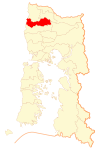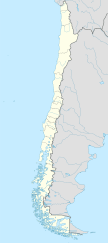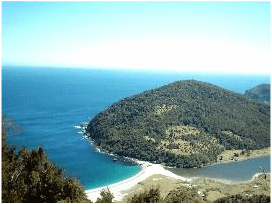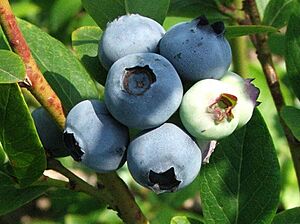Río Negro, Chile facts for kids
Quick facts for kids
Río Negro
|
||||
|---|---|---|---|---|
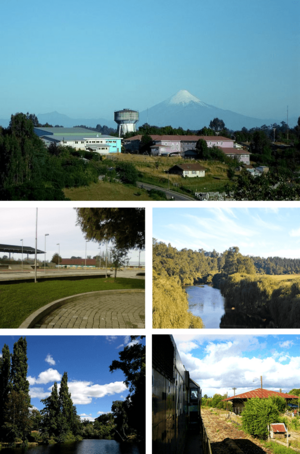
Top: Volcán Osorno, Middle left: Plaza de Armas, Middle right: Negro River seen from Chapaco Bridge, Bottom left: Locality of La Toma Bottom right: Remains of the Río Negro-Osorno railroad
|
||||
|
||||
| Country | Chile | |||
| Region | Los Lagos | |||
| Province | Osorno Province | |||
| Founded | March 12, 1896 | |||
| Government | ||||
| • Type | Municipality | |||
| Area | ||||
| • Total | 1,265.7 km2 (488.7 sq mi) | |||
| Population
(2002 Census)
|
||||
| • Total | 14,732 | |||
| • Density | 11.6394/km2 (30.1459/sq mi) | |||
| • Urban | 6,583 | |||
| • Rural | 8,149 | |||
| Demonym(s) | Rionegrino | |||
| Sex | ||||
| • Men | 7,528 | |||
| • Women | 7,204 | |||
| Time zone | UTC−4 (CLT) | |||
| • Summer (DST) | UTC−3 (CLST) | |||
| Area code(s) | 56 + 64 | |||
| Climate | Cfb | |||
| Website | Municipality of Rio Negro | |||
Río Negro, which means Black River in Spanish, is a city and a type of local government area called a commune in Chile. It is located in the Osorno Province, which is part of the Los Lagos Region.
The city is about 38 kilometers (24 miles) south of Osorno. It is also 6 kilometers (4 miles) west of Route 5, a major highway in Chile. Río Negro covers an area of 1,266 square kilometers (about 489 square miles).
According to a 2002 count, 14,732 people lived in Río Negro. This included 7,204 women and 7,528 men. The commune shares its borders with several other places. To the north, it borders Osorno and San Juan de la Costa. To the east, it borders Puerto Octay, and to the south, Purranque. The Pacific Ocean is to its west.
Contents
History of Río Negro
Early Days and Founding
In the 1800s, the area that is now Río Negro was a large property. It was located between Chahuilco and Purranque. The native Huilliche called this land Curileufu.
The town of Río Negro was officially started on March 12, 1896. This happened on land that was given by Jose Miguel Alderete. The very first alcalde (which is like a mayor) of Río Negro was Pedro González.
Population and How People Live
Understanding the Population
A census is an official count of the population. According to the 2002 census by the National Statistics Institute, Río Negro had 14,732 people. There were 7,528 men and 7,204 women.
Urban and Rural Living
Of these residents, 6,583 people (about 44.7%) lived in urban areas. Urban areas are like cities or towns. The other 8,149 people (about 55.3%) lived in rural areas. Rural areas are countryside places, often with farms.
Between 1992 and 2002, the population of Río Negro decreased by 8.1%. This means 1,294 fewer people lived there in 2002 compared to 1992.
Local Government and Leadership
How Río Negro is Governed
Río Negro is a commune, which is a local government area in Chile. It is managed by a municipal council. This council is led by an alcalde, who is elected directly by the people every four years.
The alcalde from 2008 to 2012 was Carlos Schwalm Urzúa, who belonged to the RN political party.
Members of the Council
The municipal council also had several other members:
- Carlos Kusch (UDI)
- Pedro Carreño (PDC)
- Jaime Ramos (Ind.-PS)
- Patricio Alvarado (Ind.-RN)
- Juan Saldivia Quintullanca (Ind.-PRI)
- Rosiel del Río (Ind.-UDI)
Places and Areas in Río Negro
Río Negro commune includes several smaller towns and areas. These are some of the main ones:
- Riachuelo
- Chifin
- Huellelhue Beach
- Huilma
- Millantué
- Chan-Chan
- Chahuilco
- Ñancuan
- Tres Esteros
- Río Blanco
- El Bolsón
Climate of Río Negro
The climate in Río Negro is an oceanic climate. This type of climate is also known as Köppen: Cfb. It means the area has mild temperatures throughout the year. The average temperature is about 11.4 °C (52.5 °F).
See also
 In Spanish: Río Negro (comuna) para niños
In Spanish: Río Negro (comuna) para niños


